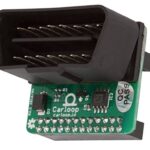Navigating the world of BMW diagnostics can often feel like deciphering a complex code, especially when dealing with the iconic E36 generation. A common question that arises among E36 owners revolves around the compatibility of E36 Obd1 To Obd2 Adapters. Do these adapters effectively bridge the gap between older BMW diagnostic systems and modern OBD2 scanners? This article dives deep into the realities of using OBD1 to OBD2 adapters on your E36, clarifying the myths and offering expert insights for accurate vehicle diagnostics.
Understanding OBD1 and OBD2 in the E36 Context
To grasp the complexities of e36 obd1 to obd2 adapters, it’s crucial to first understand the fundamental differences between OBD1 and OBD2 systems, particularly as they pertain to the BMW E36. Early E36 models, primarily those produced before 1996, are often referred to as OBD1. These vehicles typically feature a 20-pin diagnostic connector under the hood. It’s important to note that this 20-pin connector is not an OBD2 standard. It utilizes different protocols and pin configurations compared to the 16-pin OBD2 port mandated in later vehicles.
OBD2, or On-Board Diagnostics II, is a standardized system that became mandatory in the United States for all cars manufactured after 1996. OBD2 brought about significant advancements in diagnostic capabilities, standardization of diagnostic trouble codes (DTCs), and a universal 16-pin diagnostic connector. Later E36 models, especially those produced closer to and after 1996, might feature a 16-pin OBD2 port in the cabin, in addition to the 20-pin connector under the hood.
The Reality of OBD1 to OBD2 Adapters for E36 BMWs
The allure of an e36 obd1 to obd2 adapter is understandable. Owners of older E36s naturally seek a straightforward way to use readily available and often more affordable OBD2 scanners on their vehicles. However, the functionality of these adapters is often misconstrued.
An up-close view of a BMW E36’s 20-pin diagnostic connector, highlighting its pin layout and physical characteristics, which are distinct from the OBD2 standard.
Simply plugging an e36 obd1 to obd2 adapter into the 20-pin connector does not magically transform your OBD1 system into OBD2. These adapters are essentially physical converters, changing the pin configuration from the 20-pin BMW connector to the 16-pin OBD2 format. They do not bridge the communication protocol gap between OBD1 and OBD2.
As experienced BMW technicians and forum users have noted, generic OBD2 scanners, even high-end ones, often fail to communicate with the OBD1 systems in older E36s, even when using an adapter. This is because the underlying communication protocols are different. OBD1 systems in E36s require different diagnostic interfaces and software to properly read fault codes and access vehicle data.
When Might an OBD2 Adapter Seem to Work?
Confusion sometimes arises because some later E36 models, particularly those with both 20-pin and 16-pin connectors, might exhibit partial compatibility with OBD2 scanners via an adapter. These later models, especially the 328i and similar variants, have ECUs that are capable of OBD2 communication to some extent. However, even in these cases, the OBD2 functionality is often limited.
Using an e36 obd1 to obd2 adapter and a generic OBD2 scanner on a later E36 might allow you to read some basic engine fault codes. However, it’s unlikely to provide access to all modules (like ABS, instrument cluster – KOMBI, etc.) or offer the comprehensive diagnostic capabilities needed for thorough troubleshooting. For these modules, even on later E36s with a 16-pin port, the older ADS (Automatic Data Stream) protocol might still be in use, requiring specialized interfaces.
The Right Tools for E36 Diagnostics
For accurate and comprehensive diagnostics on your E36 BMW, especially if it’s an earlier OBD1 model, relying solely on an e36 obd1 to obd2 adapter and a generic OBD2 scanner is not advisable. Instead, consider the following approaches:
- BMW Specific Diagnostic Tools: Software like INPA (Inpa Product Activation) along with an ADS interface (for older modules) or a KKL cable (for engine and some other modules on later cars) are often necessary for full access to your E36’s diagnostic systems. These tools communicate using the protocols that BMW originally designed for these vehicles.
- Professional Scanners with BMW Compatibility: High-end professional diagnostic scanners, like some Snap-On models, may have the capability to communicate with older BMW systems via the 20-pin connector, sometimes requiring specific adapters within their professional kits. However, these are significantly more expensive than generic OBD2 scanners.
Conclusion: Navigate E36 Diagnostics with Informed Choices
In conclusion, while e36 obd1 to obd2 adapters exist, it’s crucial to understand their limitations. They are physical connector converters, not protocol converters. For true OBD1 E36 systems, these adapters will likely not enable communication with standard OBD2 scanners. Later E36 models might show limited OBD2 compatibility through adapters, but comprehensive diagnostics often require BMW-specific tools and interfaces.
When diagnosing your E36, especially if you own an older model, investing in the correct diagnostic tools and understanding the nuances of BMW’s diagnostic systems will save you time, frustration, and ensure accurate troubleshooting. Don’t rely on the myth of a simple e36 obd1 to obd2 adapter as a universal solution – informed choices are key to effectively maintaining your classic BMW.

